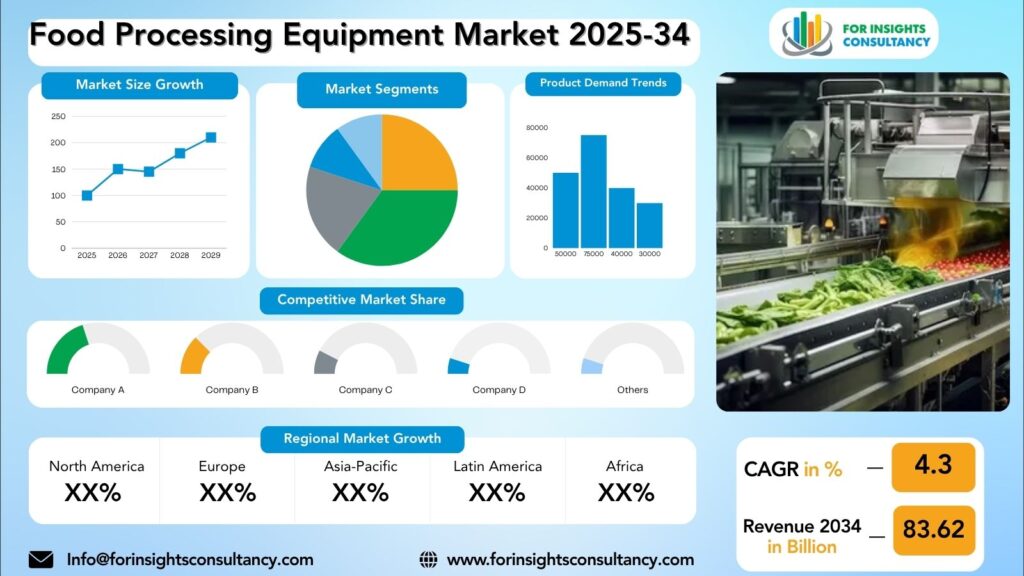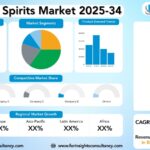
Food Processing Equipment Market Size, Trends Analysis Research Report By Equipment Type (Processing Equipment, Pre-Processing Equipment,Ancillary Equipment), by Mode of Operation (Automatic, Semi-Automatic, Manual), by Application (Bakery & Confectionery, Meat, Poultry, and Seafood, Dairy Products, Beverages (Alcoholic and Non-Alcoholic), Fruit, Nut, and Vegetable, Grains, Others), and By Region Global Market Analysis And Forecast, 2025-2034
Sep-2025 Formats | PDF | Category: Food & Beverages | Delivery: 24 to 72 Hours
The report highlights that the market outlook is significantly influenced by swift shifts in global trade relations and tariffs. It emphasizes the necessity of updating the report before delivery to incorporate the most current status, which includes revised market forecasts and a comprehensive analysis of the quantified impacts of these changes.
Food Processing Equipment Market Is Forecast to Increase from USD 64.18 Billion In 2025 To USD 47.56 Billion By 2034, At A CAGR Of 4.3%.
Food Processing Equipment Market: A Comprehensive Overview and Future Developments
The food processing equipment market is integral to the food industry, significantly enhancing efficiency, safety, and quality in food production. This overview examines the main players, trends, technological advancements, and growth potential within the sector. With a rising global demand for processed food products, the market for food processing equipment is poised for considerable growth in the upcoming years. Future industry developments are anticipated to emphasize automation, sustainability, and innovation to cater to changing consumer preferences and meet regulatory standards. As food manufacturers work towards optimizing operations and reducing waste, the increased adoption of advanced food processing solutions is expected to foster ongoing progress and enhancements throughout the industry.
Market Insights
- Asia Pacific held the largest revenue share in the global Food Processing Equipment Market in 2024, with figures generally reported to be over 37.3%.
- The urban population percentage in the United States in 2024 is consistently reported as 83.48%.
- The automatic segment held the largest market share in 2024, generally reported to be over 51%.
- The segment with the largest revenue share in the application analysis for 2024 is generally cited as Meat, Poultry, and Seafood, or alternatively, Bakery and Confectioneries (which in some reports is cited as leading with over 20% in 2024).
- The Processing equipment segment held the largest market share in 2024, with shares typically reported as over 54.8%
AI Impact
The food processing equipment market is undergoing a remarkable transformation due to the integration of artificial intelligence (AI) technology. This advancement is fundamentally revolutionizing various aspects of the industry by significantly enhancing efficiency, accuracy, and productivity within food processing operations. AI-powered solutions are being employed to streamline essential processes such as sorting, grading, quality control, and packaging. These improvements lead to higher product quality and a reduction in waste, which are crucial factors for both operational success and environmental sustainability.
Furthermore, the utilization of machine learning algorithms and predictive analytics allows food processing equipment to adapt dynamically to changing variables in real-time. This capability optimizes production outcomes and enhances operational flexibility, making it easier for manufacturers to respond to market demands and fluctuations. AI’s integration is also facilitating improved traceability in food supply chains, which is critical for compliance with stringent food safety regulations. This ensures that consumer trust and satisfaction are maintained, as traceability enhances transparency regarding product origins and safety practices.
Overall, the influence of AI on the food processing equipment market is not just about technological enhancement; it is shaping a more innovative and sustainable future for the entire industry, where efficiency and safety go hand in hand, catering to the evolving needs of consumers and regulatory bodies alike.
Market Dynamics
Trends
Trends in the food processing equipment market are prominently characterized by a growing emphasis on automation and digitization aimed at enhancing operational efficiency and ensuring stringent quality control. Manufacturers are increasingly channeling investments into advanced smart technologies, notably the Internet of Things (IoT) and artificial intelligence (AI), which facilitate streamlined operations and significantly lower production costs. In parallel, sustainability stands out as a pivotal trend, evidenced by a marked rise in demand for eco-friendly equipment designed to minimize both energy consumption and waste generation. Additionally, the market shows a pronounced preference for modular and flexible equipment solutions capable of swiftly adapting to evolving production requirements and accommodating a diverse array of food products. Collectively, these developments highlight the food processing equipment industry’s adaptation to the evolving expectations of modern consumers while adhering to strict food safety regulations.
Growth Drivers
The global food processing equipment market is undergoing substantial growth, influenced by several pivotal factors. A primary driver is the escalating demand for processed and convenience foods, which has emerged due to evolving consumer lifestyles and preferences. Additionally, there is a pressing need for efficient and cost-effective equipment to satisfy the surging global demand for food products. Technological advancements, particularly in automation and robotics, are significantly enhancing processing efficiency while simultaneously lowering labor costs. Furthermore, stringent food safety regulations and an emphasis on upholding food quality are compelling manufacturers to invest in equipment that complies with these standards, thereby further propelling the growth of the food processing equipment market.
Restraints
Restraints in the food processing equipment market are multifaceted and significantly impede the growth and innovation within the sector. One of the primary barriers is the high initial investment cost required for advanced machinery, which particularly affects small and medium-sized enterprises (SMEs) that may lack the necessary capital to adopt new technologies. Additionally, the market is challenged by stringent regulations and standards enforced by regulatory bodies, which can stifle innovation and limit the potential for growth.
Furthermore, the shortage of a skilled workforce capable of operating and maintaining sophisticated equipment further complicates the ability of companies to expand their operations effectively. This lack of skilled labor not only affects daily operations but can also impede the introduction of new technologies and processes.
On an economic level, manufacturers face the burden of fluctuating prices for both raw materials and energy, which can destabilize production costs and impact overall profitability. Lastly, heightened concerns around food safety and hygiene have resulted in increased scrutiny from regulatory authorities, leading to more stringent compliance requirements that, in turn, add to operational costs for companies in the industry. Thus, the combination of financial, regulatory, operational, and economic challenges creates a complex landscape for the food processing equipment market, hindering its development and efficiency.
Opportunities
The food processing equipment market is experiencing considerable growth opportunities, largely attributed to the increasing demand for processed and packaged food products. This surge is linked to higher disposable incomes and shifts in consumer lifestyles, resulting in a notable preference for convenience foods. As a consequence, there is a heightened requirement for food processing equipment. In parallel, technological advancements—including automation, robotics, and artificial intelligence—are significantly improving the efficiency and output of food processing operations, thereby creating additional market opportunities. Additionally, stringent regulations concerning food safety and quality standards are driving food manufacturers to invest in advanced processing equipment to ensure compliance with these regulations. Consequently, the food processing equipment market is expected to expand further as the food industry evolves in response to changing consumer preferences and regulatory demands.
Challenges
Challenges in the food processing equipment market revolve around several key issues. Firstly, there is increasing competition that pressures market players to innovate continuously. Evolving consumer preferences demand more efficient and sustainable processing equipment, pushing companies to adapt quickly to these changes. Furthermore, stringent regulations necessitate compliance, which can be resource-intensive and adds to operational costs. Rising operational costs, including fluctuations in raw material prices and the necessity for regular maintenance, also hinder industry growth. To remain competitive, companies are required to invest significantly in research and development, focusing on the creation of advanced technologies that can enhance processing efficiency and lower energy consumption. Lastly, ensuring food safety and quality remains paramount throughout the entire processing chain, presenting an ongoing challenge for equipment manufacturers in this market.
Food Processing Equipment Market Top Companies Covered In This Report:
Evaluate The Strategic Positioning And Innovation Pipelines Of Leading Market Companies-From Multinational Enterprises To Disruptive Regional Firms. Understand How Key Players Are Innovating, Expanding, And Capturing Value, And Use Competitive Benchmarks To Plan Your Next Move.
- GEA Group Aktiengesellschaft
- The Middleby Corporation
- Tetra Laval International S.A.
- BAADER Group
- Marel
- Bühler AG
- ENCO Food Machinery s.r.l.
- Bigtem Makine A.S.
- TNA Australia Pty Limited
- Alfa Laval
- Krones AG
- JBT Corporation
- SPX Flow Inc.
- LEHUI
- Equipamientos Cárnicos, S.L. (MAINCA)
Food Processing Equipment Market Company News 2024 and 2025
JBT Corporation
Announced plans to acquire Structural Concepts Corp., a U.S. manufacturer of refrigerated/heated display cases, to strengthen its foodservice and retail presence.
Introduced the Efficient Agitation (EA) Retort, engineered to optimize sterilization cycles while being gentle on fragile packaging formats.
Krones AG
Acquired Netstal Maschinen AG (March 2024), a key move to integrate Netstal’s injection molding technology, complementing Krones’ packaging machinery portfolio.
Reported a strong start, continuing a profitable growth path based on robust customer investment, especially in the beverage and liquid food sectors.
Marel
Demonstrating the latest advancements in heat processing equipment at trade shows in 2024, focusing on advanced features designed to improve food safety and extend product shelf life.
Segmented View of The Industry:
The Food Processing Equipment Market Is Mapped Through A Multidimensional Lens-Tracking Shifts Across Product Type, Applications, And Geographic Regions. This Segmented Approach Enables Businesses to Localize Their Growth Plans And Align Offerings With The Most Profitable Demand Centres.
Segmentation By Processing Equipment
- Thermal Equipment (Ovens, Dryers, Sterilizers)
- Mixing and Blending Equipment
- Forming and Extruding Machines
- Refrigeration and Freezing Equipment (Cooling & Freezing)
- Coating Equipment
Segmentation ByPre-Processing Equipment
- Washing Systems
- Sorting & Grading Equipment
- Cutting, Slicing, Peeling, and Grinding Equipment
- Mixing & Blending (used at this stage as well)
Segmentation ByAncillary Equipment
- Packaging Equipment
- Utilities (air, water purification, etc.)
Segmentation By Mode of Operation
- Automatic
- Semi-Automatic
- Manual
Segmentation By Application
- Bakery & Confectionery
- Meat, Poultry, and Seafood (Often a major or leading segment)
- Dairy Products
- Beverages (Alcoholic and Non-Alcoholic)
- Fruit, Nut, and Vegetable
- Grains
- Others
Global Geographic Coverage:
The Report Provides In-Depth Qualitative And Quantitative Data On The Food Processing Equipment Market For All Of The Regions And Countries Listed Below:
North America
The Food Processing Equipment Market in North America is anticipated to maintain steady growth in the coming years, fueled by a projected GDP growth of 2.5% and an inflation rate of 1.8%. A significant, local, and non-replicable driver for this market is the rising demand for sustainability and ethical sourcing practices among consumers, who are increasingly seeking transparency in the origin of ingredients and materials utilized in food processing equipment.
Established distributors and retailers remain the primary sales channel for food processing equipment in North America, while direct-to-consumer sales via e-commerce platforms are recognized as the fastest-growing segment. This shift indicates a changing landscape where sustainability, ethical sourcing, and local production are prioritized by consumers, reflecting their heightened awareness of the environmental and social ramifications of their purchasing choices. In contrast, emerging markets still primarily focus on price and status; however, a gradual transition towards sustainable and ethically-produced goods is noted, suggesting an evolving consumer preference across different regions.
Europe
The Food Processing Equipment Market in Europe is poised for consistent growth, underpinned by an expected GDP increase of 3% and a stable inflation rate of 1.5% throughout the forecast period. A notable factor influencing this market trend is a government subsidy in France, which incentivizes investments in sustainable food processing technologies, thereby significantly boosting the demand for eco-friendly options. The primary distribution channel for food processing equipment in the region is through specialized industrial suppliers; however, online sales are rapidly expanding as consumers gravitate towards digital purchasing solutions. This shift aligns with a broader European consumer trend that increasingly emphasizes sustainability, ethical sourcing, and localism. As a result, producers must adapt their practices to meet these expectations. Additionally, in various emerging markets where price and social status are traditionally prioritized, there is a notable transition towards ethical and sustainable food processing methods, driven by both consumer preferences and regulatory pressures.
Asia Pacific
The Food Processing Equipment Market in the Asia Pacific region is set for considerable growth, anticipating a GDP increase of 5% and an inflation rate of 2%. In Japan, the market is significantly influenced by a governmental subsidy aimed at encouraging the use of advanced food processing technologies to improve food safety and quality. The primary distribution channel for food processing equipment in Japan is direct sales to large food processing firms; however, online sales platforms targeting small and medium-sized enterprises represent the fastest-growing distribution method. Japanese consumers demonstrate a strong preference for sustainability and ethical sourcing in their food processing equipment choices, indicating these factors are essential for successful product offerings. Additionally, local manufacturing holds substantial value among consumers, who show a preference for equipment produced domestically. In contrast, in emerging markets where price and status are key considerations, strategies focused on maintaining competitive pricing along with emphasizing the prestige of the equipment can prove crucial for market success.
Middle East and Africa
The Food Processing Equipment Market in the Middle East and Africa is anticipated to experience consistent growth, aided by a GDP growth rate of 3% and an inflation rate of 2% within the region. Particularly in Egypt, a key factor driving market expansion is the government’s subsidy aimed at modernizing food processing facilities, which seeks to enhance operational efficiency and mitigate food wastage. The primary distribution channel for food processing equipment in this area remains specialized distributors; however, e-commerce is emerging as the fastest-growing avenue, attributed to rising digitalization trends. Additionally, there is an increasing consumer demand for sustainability and ethical sourcing practices in food production, compelling manufacturers to adopt these practices to build consumer trust. Nevertheless, in various emerging markets, consumer preferences are heavily influenced by price and status, presenting significant challenges for companies that prioritize sustainability and localism in their operations.
Reasons To Buy:
- The Research Would Help Top Administration/Policymakers/Professionals/Product Advancements/Sales Managers And Stakeholders In This Market In The Following Ways.
- The Report Provides Food Processing Equipment Market Revenues At The Worldwide, Regional, And Country Levels With A Complete Analysis To 2034 Permitting Companies To Analyze Their Market Share And Analyze Projections, And Find New Markets To Aim For.
- To Understand The Most Affecting Driving And Restraining Forces In The Market And Their Impact On The Global Market.
- Major Changes And Assessment In Market Dynamics And Developments.
- The Objective Of The Food Processing Equipment Market Report Is To Identify New Business Opportunities Using Quantitative Market Forecasts.
- Formulate Sales And Marketing Strategies By Gaining An Understanding Of Competitors, Their Positioning, And Strengths & Weaknesses.
Faq – What Global Leaders Are Asking
What Is The Growth Prospect For The Food Processing Equipment Market By 2034?
Food Processing Equipment Market Is Expected To Achieve A Stable Growth Rate With A Compound Annual Growth Rate (CAGR) Of About 4.3% From 2025 Through 2034.
What Is Driving The Growth Of The Food Processing Equipment Market?
The market growth is primarily driven by the rising global demand for processed and convenience foods due to urbanization and busy lifestyles. This demand compels manufacturers to invest in automation, smart technologies (Industry 4.0), and efficient equipment to meet stringent food safety and quality standards.
This escalating threat landscape is compounded by accelerated digital transformation (cloud migration, remote work) and stringent global regulatory compliance.
Who Are The Key Players In The Food Processing Equipment Market, And What Are Their Market Shares?
The Food Processing Equipment Market Includes Major Companies GEA Group Aktiengesellschaft, The Middleby Corporation, Tetra Laval International S.A., BAADER Group, Marel, Bühler AG, ENCO Food Machinery s.r.l., Bigtem Makine A.S., TNA Australia Pty Limited, Alfa Laval, Krones AG, JBT Corporation, SPX Flow Inc., LEHUI, Equipamientos Cárnicos, S.L. (MAINCA), Others.
Specific Market Share Data Is Not Publicly Available And Is Typically Provided In Detailed, Proprietary Market Research Reports.
Which Regions Are Leading The Food Processing Equipment Market Growth?
The Asia-Pacific region is the fastest-growing market, driven by rapid urbanization and soaring demand for processed foods in countries like China and India. However, North America and Europe currently hold the largest market share due to established, high-value food processing industries and continuous technological upgrades.
Customized Report as per your Business Needs
- Our analysts will work directly with you and understand your needs
- Get data on specified regions or segments, competitor and Vendors
- Data will be formatted and presented as per your requirements
Any Requirement Contact Us: Https://Www.Forinsightsconsultancy.Com/Contact-Us/
Table of Contents
For TOC Contact us: https://forinsightsconsultancy.com/contact-us/







